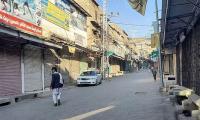My parents, like millions of others, opted to migrate to Pakistan leaving their entire belongings behind. What they could not leave though were the cherished memories connected to childhood friends, and the home they lived in. The bitter experience they went through during the journey and after arriving at their new soil also continued to haunt them. The past started to diminish as we, the children of immigrants, started to thrive in their new home.
Generally, invasion, conquest, colonization, poor economic conditions have been the unwarranted causes of forced or unwilling migration. This brought deaths, collateral loss, loot, and invariably produced refugees and asylum seekers.
Pakistan has for decades confronted the challenge of unplanned migration mainly due to economic, security, social, political, environmental, and geographical reasons. The main bulk of resettlement however took place around four major happenings – in 1947 during the partition of India (14 million), the 1971 creation of Bangladesh (10 million), 1978-89 during the Soviet-Afghan War (6.3 million), and the post 9/11 law and order situations (5.3 million).
At present, there are 1.44 million registered Afghan refugees out of which only 31 percent reside inside camps. Now with the ongoing withdrawal of Nato forces and the fight among the warring factions of Afghanistan, we are likely to see a fresh influx of refugees from across the borders.
Earlier, with the help of UNHCR/UNDP, measures taken by Pakistan to launch the Refugee Hosting Area (RAHA). Its sustenance had gone a long way in preserving a temporary safety space, encouraging peaceful coexistence and social interconnection among refugees, beside tackling the possibility of any xenophobic feelings among the groups.
Unplanned migration along with urbanization is a serious trend taking momentum mainly due to economic and security reasons. The ongoing pandemic, which has reshaped everyone’s way of life has additionally resulted in a massive inflow of Pakistanis from the Gulf, Europe, and the US to our cities. This has led to the peripheral growth of major cities.
Studies reveal that policy architects can slow down rural-urban migration by generating additional work prospects in rural areas through investment (the Todaro Model). The potential number of migrants will be higher where the population of those departing and arriving is large, friction of distance acts as a break (Gravity Model). Nonetheless, intervening obstacles like language, illiteracy, travel costs, family pressures, immediate job opportunities and others may prevent migration.
There should be no doubt that relocation too positively contributes to the local economies by creating new work-related opportunities, diversifying skills, traits and eventually helping with the improvement of the quality of people as they interact with a new culture, cuisine, attire, customs, and languages. The arrival of workers in urban areas increases the competition for jobs, houses, and school facilities. Children can avail better education opportunities.
However, not everyone fits squarely into the new environment and consequently does not receive all the benefits of an urban lifestyle. Poverty adds to the challenge of living a healthy life. Youngsters growing up in poverty invariably have no access to proper nutrition, education, or health. The lack of resources compels such groups to find refuge in slum areas where they come across problems such as unsanitary habitat, crime, pollution, and other hazards.
Undeniably, living in such poor conditions is a recipe for exploiting this marginalized group of people. Involvement in petty crimes or creating a law-and-order situation for small financial gains or even genuine demands for basic services is common, and thus increases pressure on natural resources, amenities and services.
Credibly the police, administration and other stakeholders have been assisting people in need, especially women, children, minorities and people on the move such as refugees, migrants, IDPs. Still, in a situation of unplanned migration, further challenges may arise for LEAs. Crimes of abductions, human smuggling, identity theft, encroachment, land grabbing, drug trafficking, sexual exploitation, prostitution, bonded labour can be seen as one consequence of the unplanned expansion of cities.
Legitimately, a significant challenge is to regulate such movement within a country, movement that is protected by the constitution. Fundamental rights, Article 15, provide equal rights to all citizens to choose to live in any part of the country and own property. While the police may prefer to introduce a registration process on all such movements, that would be tantamount to infringing upon basic rights.
Internal migration entails multifaceted problems, and consequently expecting law-enforcement agencies to address it independently would be unrealistic; this thus requires a multi-agency approach. It is essential that institutions, departments, agencies, civil society and legislators combine their efforts to dilute the adverse effects of internal migration.
A better way to handle unplanned migration is recognition at all levels, with a system of registration of inhabitants combined with strict watch without infringing fundamental rights, and counselling of migrants and locals’ committees for dispute resolution. If on the one hand various government departments and NGOs work for the promotion of nation-building activities, national culture and language acknowledgement, the LEAs on the other hand must take the lead for crackdown against corrupt mafias dealing in drugs, lang-grabbing, human trafficking and smuggling with strict action against bonded and forced labour.
The information-gathering mechanism needs to be transparent. Expansion of the ‘Safe City’ project to monitor response and retrieve information in case needed. Establishment of forensic labs for better investigation is imperative as the population of the area expands. Implementation of the Tenancy Act in true letter and spirit for accounting of transactions and people’s housing can also help appraise protuberance.
A successful model of monitoring has been ‘Hotel-Eye’ whose application can help examine new arrival and inmates’ credentials. Registration of property dealers to ascertain their legality in sales and purchase and an integration with NADRA is a worthwhile option. Neighborhood watch, involvement of notables, community, and local councilors, if done in letter and spirit, is bound to make a difference, easily making law enforcement judicious.
It is high time we examined this landscape of unplanned migration with fresh eyes, so as to make the process easy, safe, reassuring and appropriate as we accommodate all unprivileged, irrespective of which part of the country they are coming from, or if they are cross-border migrants.
The writer, a security expert, holds a PhD in Politics & International Relations, and is presently serving as IGP NHMP.
Email: skimam98@hotmail.com
Most recently, US presidential elections demonstrated how AI has amplified partisan split
Few years ago, Pakistan ranked as fourth-largest freelancer market globally, with potential to become number one
Arts Council Karachi celebrated its 70th birth anniversary at inaugural session with big cake
There are over 11 million Pakistanis settled abroad, out of which around six million work in Gulf and Middle East
This year alone, US Treasury would have to roll-over $10 to $14 trillion in maturing short-term debt
Tear gas no longer marks just protest sites; it paints entire cities as battlegrounds but then again, PTI did it first







